Qualitative and Quantitative Article Critique Assignment
VerifiedAdded on 2023/01/16
|10
|2737
|24
Homework Assignment
AI Summary
This assignment presents a comparative critique of two research articles: one employing a qualitative approach and the other a quantitative methodology. The qualitative study explores nurses' experiences and perspectives on preventing medication administration errors, utilizing semi-structured interviews to gather data. The quantitative study investigates the correlation between safe medication practices, workplace relationships, and support among graduate nurses, employing an online survey for data collection. The critique examines the aims, significance, methods (including sampling techniques and data collection), data analysis, results, limitations, and recommendations of each study. The assignment highlights the strengths and weaknesses of each research design, considering the appropriateness of methods and the generalizability of findings. The analysis underscores the importance of professional practice environments, continuing education, and workplace support in enhancing patient safety and minimizing medication errors. The assignment also discusses limitations such as sample size and potential biases in self-reported data.
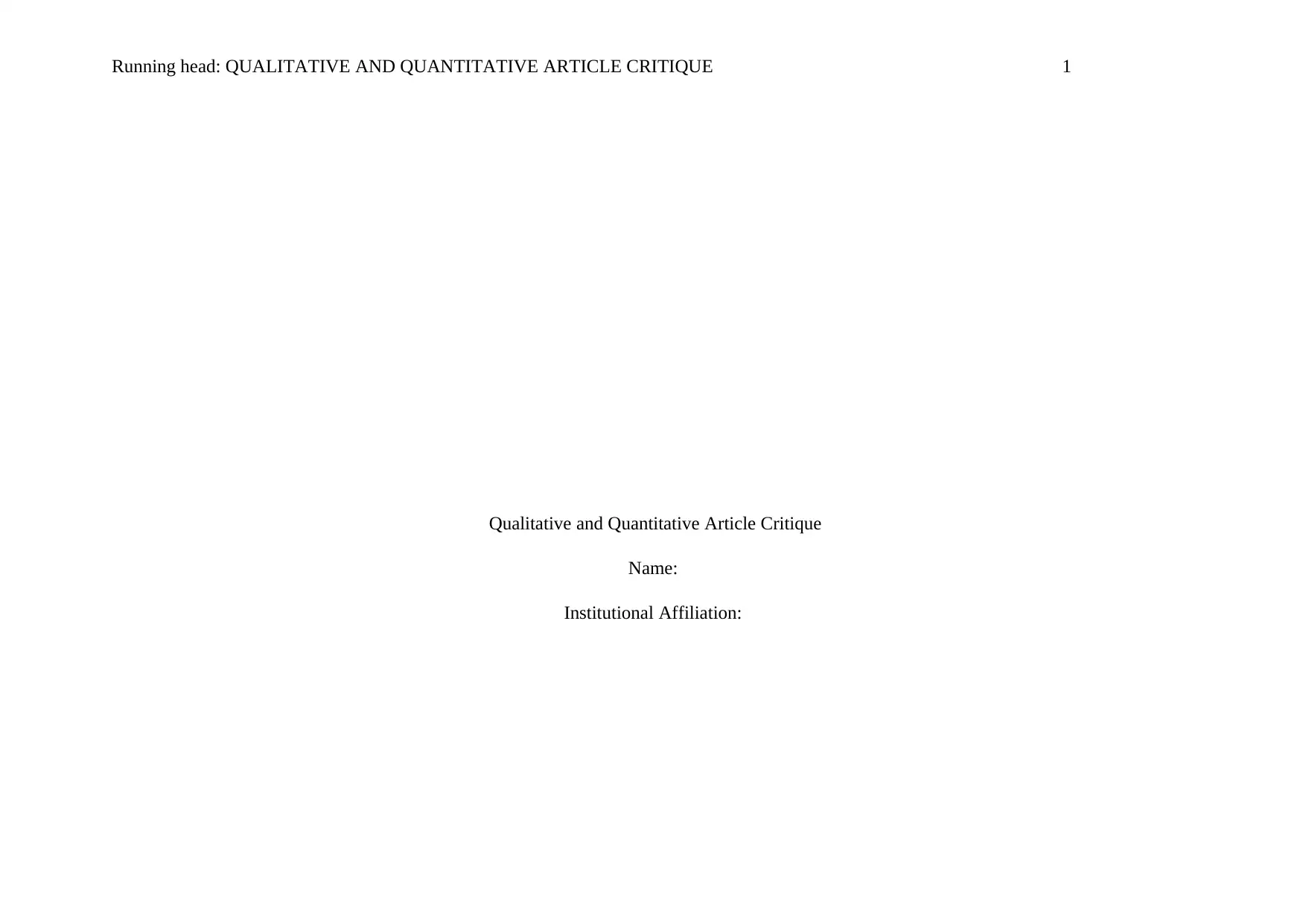
Running head: QUALITATIVE AND QUANTITATIVE ARTICLE CRITIQUE 1
Qualitative and Quantitative Article Critique
Name:
Institutional Affiliation:
Qualitative and Quantitative Article Critique
Name:
Institutional Affiliation:
Paraphrase This Document
Need a fresh take? Get an instant paraphrase of this document with our AI Paraphraser
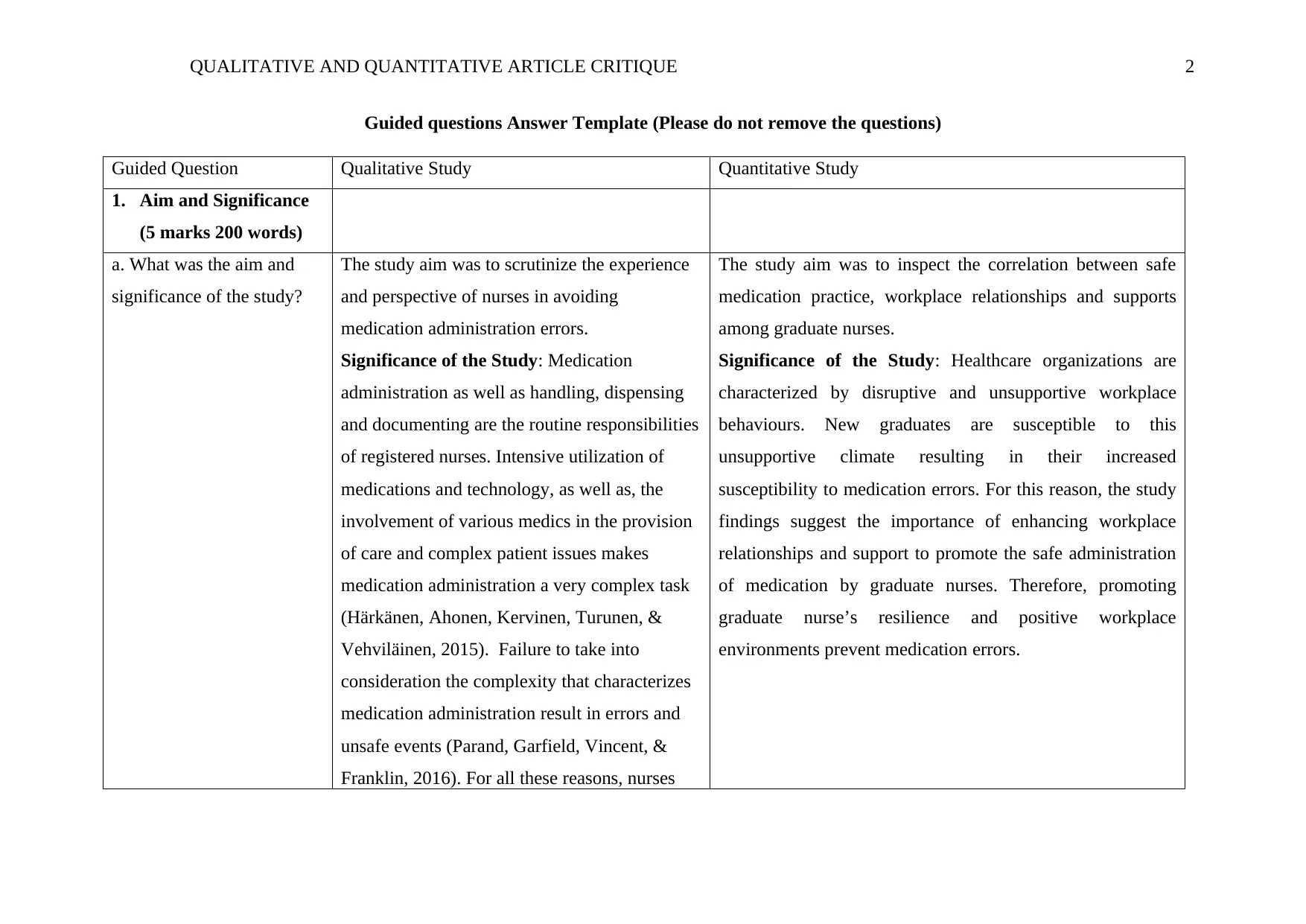
QUALITATIVE AND QUANTITATIVE ARTICLE CRITIQUE 2
Guided questions Answer Template (Please do not remove the questions)
Guided Question Qualitative Study Quantitative Study
1. Aim and Significance
(5 marks 200 words)
a. What was the aim and
significance of the study?
The study aim was to scrutinize the experience
and perspective of nurses in avoiding
medication administration errors.
Significance of the Study: Medication
administration as well as handling, dispensing
and documenting are the routine responsibilities
of registered nurses. Intensive utilization of
medications and technology, as well as, the
involvement of various medics in the provision
of care and complex patient issues makes
medication administration a very complex task
(Härkänen, Ahonen, Kervinen, Turunen, &
Vehviläinen, 2015). Failure to take into
consideration the complexity that characterizes
medication administration result in errors and
unsafe events (Parand, Garfield, Vincent, &
Franklin, 2016). For all these reasons, nurses
The study aim was to inspect the correlation between safe
medication practice, workplace relationships and supports
among graduate nurses.
Significance of the Study: Healthcare organizations are
characterized by disruptive and unsupportive workplace
behaviours. New graduates are susceptible to this
unsupportive climate resulting in their increased
susceptibility to medication errors. For this reason, the study
findings suggest the importance of enhancing workplace
relationships and support to promote the safe administration
of medication by graduate nurses. Therefore, promoting
graduate nurse’s resilience and positive workplace
environments prevent medication errors.
Guided questions Answer Template (Please do not remove the questions)
Guided Question Qualitative Study Quantitative Study
1. Aim and Significance
(5 marks 200 words)
a. What was the aim and
significance of the study?
The study aim was to scrutinize the experience
and perspective of nurses in avoiding
medication administration errors.
Significance of the Study: Medication
administration as well as handling, dispensing
and documenting are the routine responsibilities
of registered nurses. Intensive utilization of
medications and technology, as well as, the
involvement of various medics in the provision
of care and complex patient issues makes
medication administration a very complex task
(Härkänen, Ahonen, Kervinen, Turunen, &
Vehviläinen, 2015). Failure to take into
consideration the complexity that characterizes
medication administration result in errors and
unsafe events (Parand, Garfield, Vincent, &
Franklin, 2016). For all these reasons, nurses
The study aim was to inspect the correlation between safe
medication practice, workplace relationships and supports
among graduate nurses.
Significance of the Study: Healthcare organizations are
characterized by disruptive and unsupportive workplace
behaviours. New graduates are susceptible to this
unsupportive climate resulting in their increased
susceptibility to medication errors. For this reason, the study
findings suggest the importance of enhancing workplace
relationships and support to promote the safe administration
of medication by graduate nurses. Therefore, promoting
graduate nurse’s resilience and positive workplace
environments prevent medication errors.
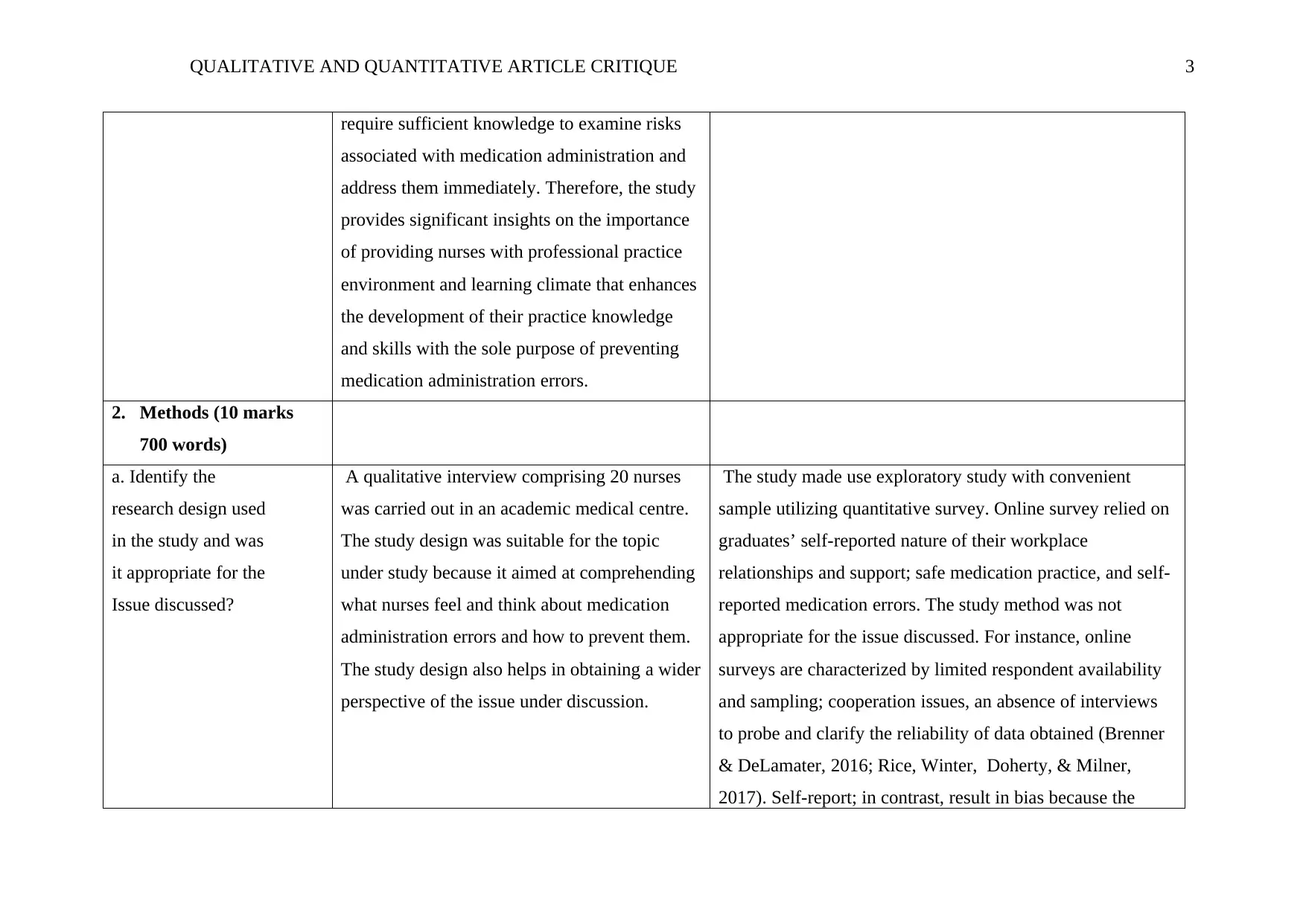
QUALITATIVE AND QUANTITATIVE ARTICLE CRITIQUE 3
require sufficient knowledge to examine risks
associated with medication administration and
address them immediately. Therefore, the study
provides significant insights on the importance
of providing nurses with professional practice
environment and learning climate that enhances
the development of their practice knowledge
and skills with the sole purpose of preventing
medication administration errors.
2. Methods (10 marks
700 words)
a. Identify the
research design used
in the study and was
it appropriate for the
Issue discussed?
A qualitative interview comprising 20 nurses
was carried out in an academic medical centre.
The study design was suitable for the topic
under study because it aimed at comprehending
what nurses feel and think about medication
administration errors and how to prevent them.
The study design also helps in obtaining a wider
perspective of the issue under discussion.
The study made use exploratory study with convenient
sample utilizing quantitative survey. Online survey relied on
graduates’ self-reported nature of their workplace
relationships and support; safe medication practice, and self-
reported medication errors. The study method was not
appropriate for the issue discussed. For instance, online
surveys are characterized by limited respondent availability
and sampling; cooperation issues, an absence of interviews
to probe and clarify the reliability of data obtained (Brenner
& DeLamater, 2016; Rice, Winter, Doherty, & Milner,
2017). Self-report; in contrast, result in bias because the
require sufficient knowledge to examine risks
associated with medication administration and
address them immediately. Therefore, the study
provides significant insights on the importance
of providing nurses with professional practice
environment and learning climate that enhances
the development of their practice knowledge
and skills with the sole purpose of preventing
medication administration errors.
2. Methods (10 marks
700 words)
a. Identify the
research design used
in the study and was
it appropriate for the
Issue discussed?
A qualitative interview comprising 20 nurses
was carried out in an academic medical centre.
The study design was suitable for the topic
under study because it aimed at comprehending
what nurses feel and think about medication
administration errors and how to prevent them.
The study design also helps in obtaining a wider
perspective of the issue under discussion.
The study made use exploratory study with convenient
sample utilizing quantitative survey. Online survey relied on
graduates’ self-reported nature of their workplace
relationships and support; safe medication practice, and self-
reported medication errors. The study method was not
appropriate for the issue discussed. For instance, online
surveys are characterized by limited respondent availability
and sampling; cooperation issues, an absence of interviews
to probe and clarify the reliability of data obtained (Brenner
& DeLamater, 2016; Rice, Winter, Doherty, & Milner,
2017). Self-report; in contrast, result in bias because the
⊘ This is a preview!⊘
Do you want full access?
Subscribe today to unlock all pages.

Trusted by 1+ million students worldwide
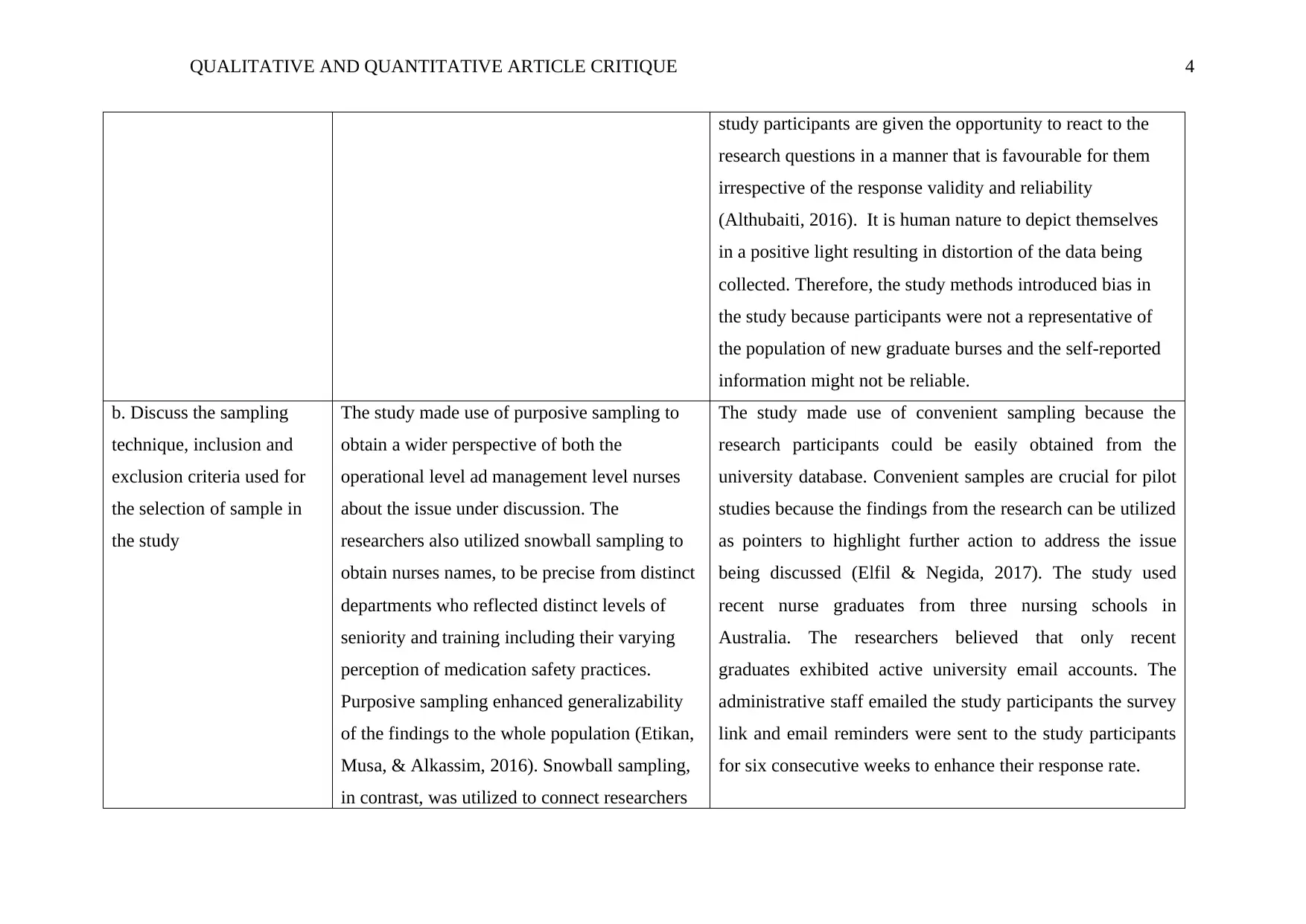
QUALITATIVE AND QUANTITATIVE ARTICLE CRITIQUE 4
study participants are given the opportunity to react to the
research questions in a manner that is favourable for them
irrespective of the response validity and reliability
(Althubaiti, 2016). It is human nature to depict themselves
in a positive light resulting in distortion of the data being
collected. Therefore, the study methods introduced bias in
the study because participants were not a representative of
the population of new graduate burses and the self-reported
information might not be reliable.
b. Discuss the sampling
technique, inclusion and
exclusion criteria used for
the selection of sample in
the study
The study made use of purposive sampling to
obtain a wider perspective of both the
operational level ad management level nurses
about the issue under discussion. The
researchers also utilized snowball sampling to
obtain nurses names, to be precise from distinct
departments who reflected distinct levels of
seniority and training including their varying
perception of medication safety practices.
Purposive sampling enhanced generalizability
of the findings to the whole population (Etikan,
Musa, & Alkassim, 2016). Snowball sampling,
in contrast, was utilized to connect researchers
The study made use of convenient sampling because the
research participants could be easily obtained from the
university database. Convenient samples are crucial for pilot
studies because the findings from the research can be utilized
as pointers to highlight further action to address the issue
being discussed (Elfil & Negida, 2017). The study used
recent nurse graduates from three nursing schools in
Australia. The researchers believed that only recent
graduates exhibited active university email accounts. The
administrative staff emailed the study participants the survey
link and email reminders were sent to the study participants
for six consecutive weeks to enhance their response rate.
study participants are given the opportunity to react to the
research questions in a manner that is favourable for them
irrespective of the response validity and reliability
(Althubaiti, 2016). It is human nature to depict themselves
in a positive light resulting in distortion of the data being
collected. Therefore, the study methods introduced bias in
the study because participants were not a representative of
the population of new graduate burses and the self-reported
information might not be reliable.
b. Discuss the sampling
technique, inclusion and
exclusion criteria used for
the selection of sample in
the study
The study made use of purposive sampling to
obtain a wider perspective of both the
operational level ad management level nurses
about the issue under discussion. The
researchers also utilized snowball sampling to
obtain nurses names, to be precise from distinct
departments who reflected distinct levels of
seniority and training including their varying
perception of medication safety practices.
Purposive sampling enhanced generalizability
of the findings to the whole population (Etikan,
Musa, & Alkassim, 2016). Snowball sampling,
in contrast, was utilized to connect researchers
The study made use of convenient sampling because the
research participants could be easily obtained from the
university database. Convenient samples are crucial for pilot
studies because the findings from the research can be utilized
as pointers to highlight further action to address the issue
being discussed (Elfil & Negida, 2017). The study used
recent nurse graduates from three nursing schools in
Australia. The researchers believed that only recent
graduates exhibited active university email accounts. The
administrative staff emailed the study participants the survey
link and email reminders were sent to the study participants
for six consecutive weeks to enhance their response rate.
Paraphrase This Document
Need a fresh take? Get an instant paraphrase of this document with our AI Paraphraser
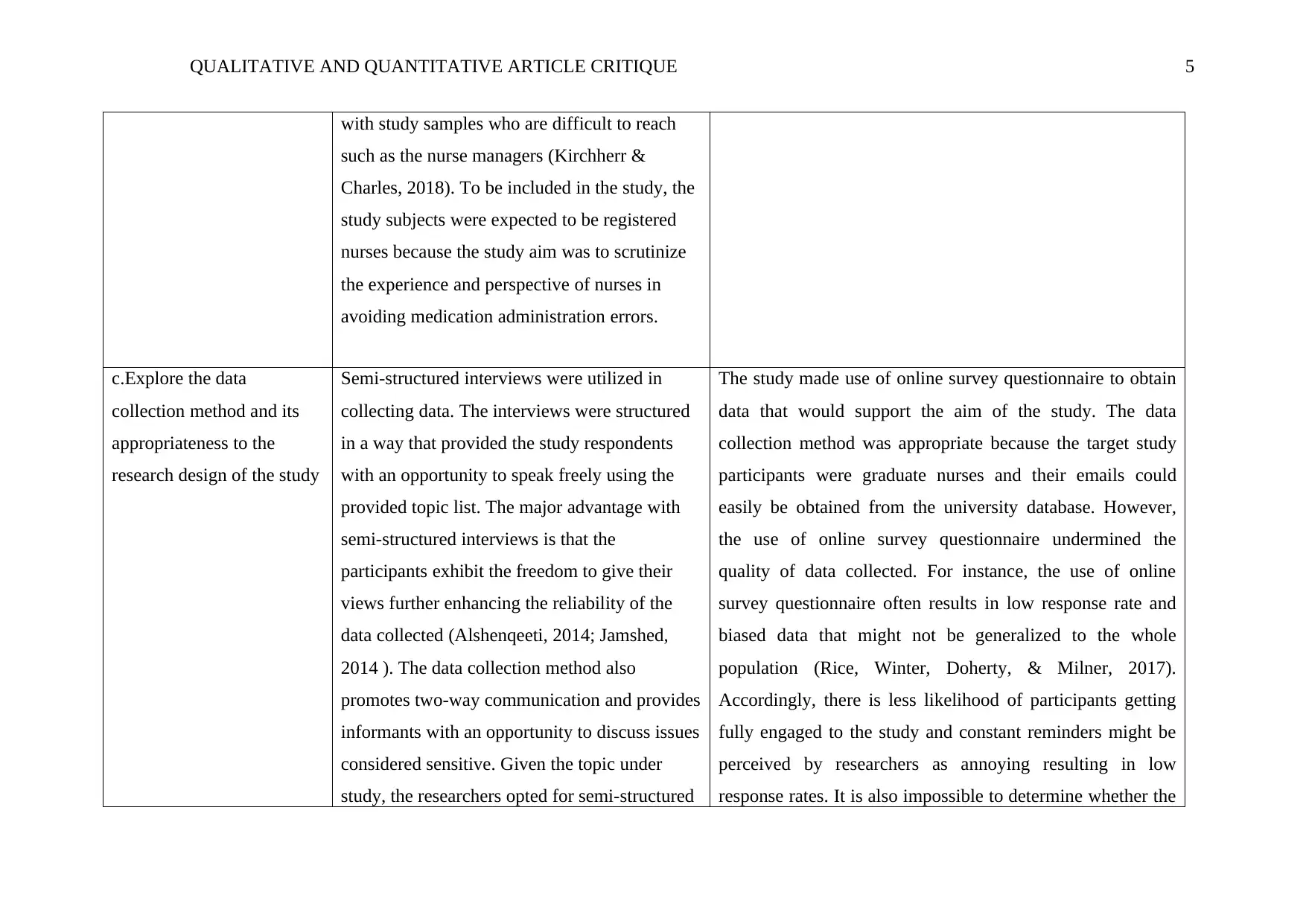
QUALITATIVE AND QUANTITATIVE ARTICLE CRITIQUE 5
with study samples who are difficult to reach
such as the nurse managers (Kirchherr &
Charles, 2018). To be included in the study, the
study subjects were expected to be registered
nurses because the study aim was to scrutinize
the experience and perspective of nurses in
avoiding medication administration errors.
c.Explore the data
collection method and its
appropriateness to the
research design of the study
Semi-structured interviews were utilized in
collecting data. The interviews were structured
in a way that provided the study respondents
with an opportunity to speak freely using the
provided topic list. The major advantage with
semi-structured interviews is that the
participants exhibit the freedom to give their
views further enhancing the reliability of the
data collected (Alshenqeeti, 2014; Jamshed,
2014 ). The data collection method also
promotes two-way communication and provides
informants with an opportunity to discuss issues
considered sensitive. Given the topic under
study, the researchers opted for semi-structured
The study made use of online survey questionnaire to obtain
data that would support the aim of the study. The data
collection method was appropriate because the target study
participants were graduate nurses and their emails could
easily be obtained from the university database. However,
the use of online survey questionnaire undermined the
quality of data collected. For instance, the use of online
survey questionnaire often results in low response rate and
biased data that might not be generalized to the whole
population (Rice, Winter, Doherty, & Milner, 2017).
Accordingly, there is less likelihood of participants getting
fully engaged to the study and constant reminders might be
perceived by researchers as annoying resulting in low
response rates. It is also impossible to determine whether the
with study samples who are difficult to reach
such as the nurse managers (Kirchherr &
Charles, 2018). To be included in the study, the
study subjects were expected to be registered
nurses because the study aim was to scrutinize
the experience and perspective of nurses in
avoiding medication administration errors.
c.Explore the data
collection method and its
appropriateness to the
research design of the study
Semi-structured interviews were utilized in
collecting data. The interviews were structured
in a way that provided the study respondents
with an opportunity to speak freely using the
provided topic list. The major advantage with
semi-structured interviews is that the
participants exhibit the freedom to give their
views further enhancing the reliability of the
data collected (Alshenqeeti, 2014; Jamshed,
2014 ). The data collection method also
promotes two-way communication and provides
informants with an opportunity to discuss issues
considered sensitive. Given the topic under
study, the researchers opted for semi-structured
The study made use of online survey questionnaire to obtain
data that would support the aim of the study. The data
collection method was appropriate because the target study
participants were graduate nurses and their emails could
easily be obtained from the university database. However,
the use of online survey questionnaire undermined the
quality of data collected. For instance, the use of online
survey questionnaire often results in low response rate and
biased data that might not be generalized to the whole
population (Rice, Winter, Doherty, & Milner, 2017).
Accordingly, there is less likelihood of participants getting
fully engaged to the study and constant reminders might be
perceived by researchers as annoying resulting in low
response rates. It is also impossible to determine whether the
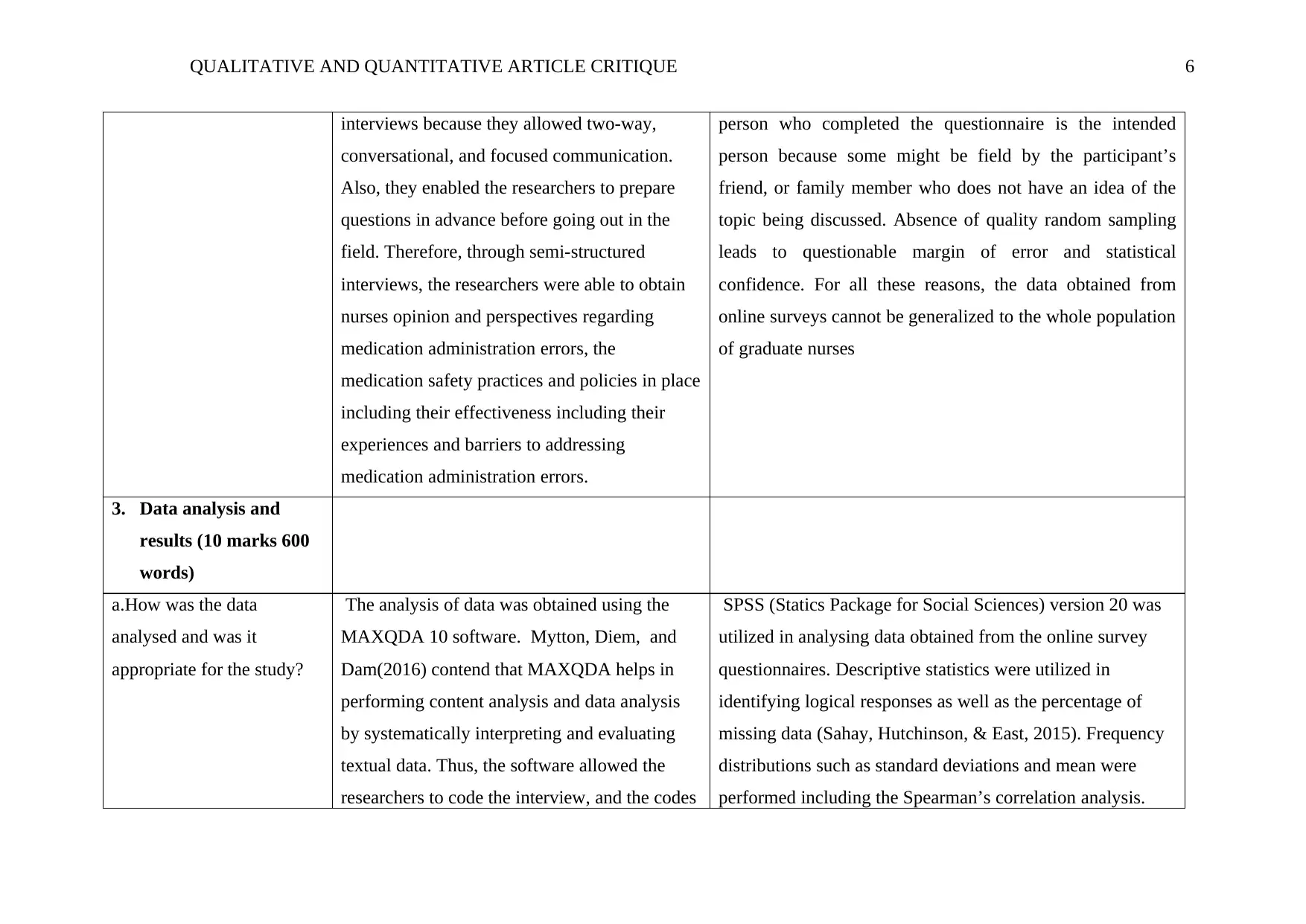
QUALITATIVE AND QUANTITATIVE ARTICLE CRITIQUE 6
interviews because they allowed two-way,
conversational, and focused communication.
Also, they enabled the researchers to prepare
questions in advance before going out in the
field. Therefore, through semi-structured
interviews, the researchers were able to obtain
nurses opinion and perspectives regarding
medication administration errors, the
medication safety practices and policies in place
including their effectiveness including their
experiences and barriers to addressing
medication administration errors.
person who completed the questionnaire is the intended
person because some might be field by the participant’s
friend, or family member who does not have an idea of the
topic being discussed. Absence of quality random sampling
leads to questionable margin of error and statistical
confidence. For all these reasons, the data obtained from
online surveys cannot be generalized to the whole population
of graduate nurses
3. Data analysis and
results (10 marks 600
words)
a.How was the data
analysed and was it
appropriate for the study?
The analysis of data was obtained using the
MAXQDA 10 software. Mytton, Diem, and
Dam(2016) contend that MAXQDA helps in
performing content analysis and data analysis
by systematically interpreting and evaluating
textual data. Thus, the software allowed the
researchers to code the interview, and the codes
SPSS (Statics Package for Social Sciences) version 20 was
utilized in analysing data obtained from the online survey
questionnaires. Descriptive statistics were utilized in
identifying logical responses as well as the percentage of
missing data (Sahay, Hutchinson, & East, 2015). Frequency
distributions such as standard deviations and mean were
performed including the Spearman’s correlation analysis.
interviews because they allowed two-way,
conversational, and focused communication.
Also, they enabled the researchers to prepare
questions in advance before going out in the
field. Therefore, through semi-structured
interviews, the researchers were able to obtain
nurses opinion and perspectives regarding
medication administration errors, the
medication safety practices and policies in place
including their effectiveness including their
experiences and barriers to addressing
medication administration errors.
person who completed the questionnaire is the intended
person because some might be field by the participant’s
friend, or family member who does not have an idea of the
topic being discussed. Absence of quality random sampling
leads to questionable margin of error and statistical
confidence. For all these reasons, the data obtained from
online surveys cannot be generalized to the whole population
of graduate nurses
3. Data analysis and
results (10 marks 600
words)
a.How was the data
analysed and was it
appropriate for the study?
The analysis of data was obtained using the
MAXQDA 10 software. Mytton, Diem, and
Dam(2016) contend that MAXQDA helps in
performing content analysis and data analysis
by systematically interpreting and evaluating
textual data. Thus, the software allowed the
researchers to code the interview, and the codes
SPSS (Statics Package for Social Sciences) version 20 was
utilized in analysing data obtained from the online survey
questionnaires. Descriptive statistics were utilized in
identifying logical responses as well as the percentage of
missing data (Sahay, Hutchinson, & East, 2015). Frequency
distributions such as standard deviations and mean were
performed including the Spearman’s correlation analysis.
⊘ This is a preview!⊘
Do you want full access?
Subscribe today to unlock all pages.

Trusted by 1+ million students worldwide
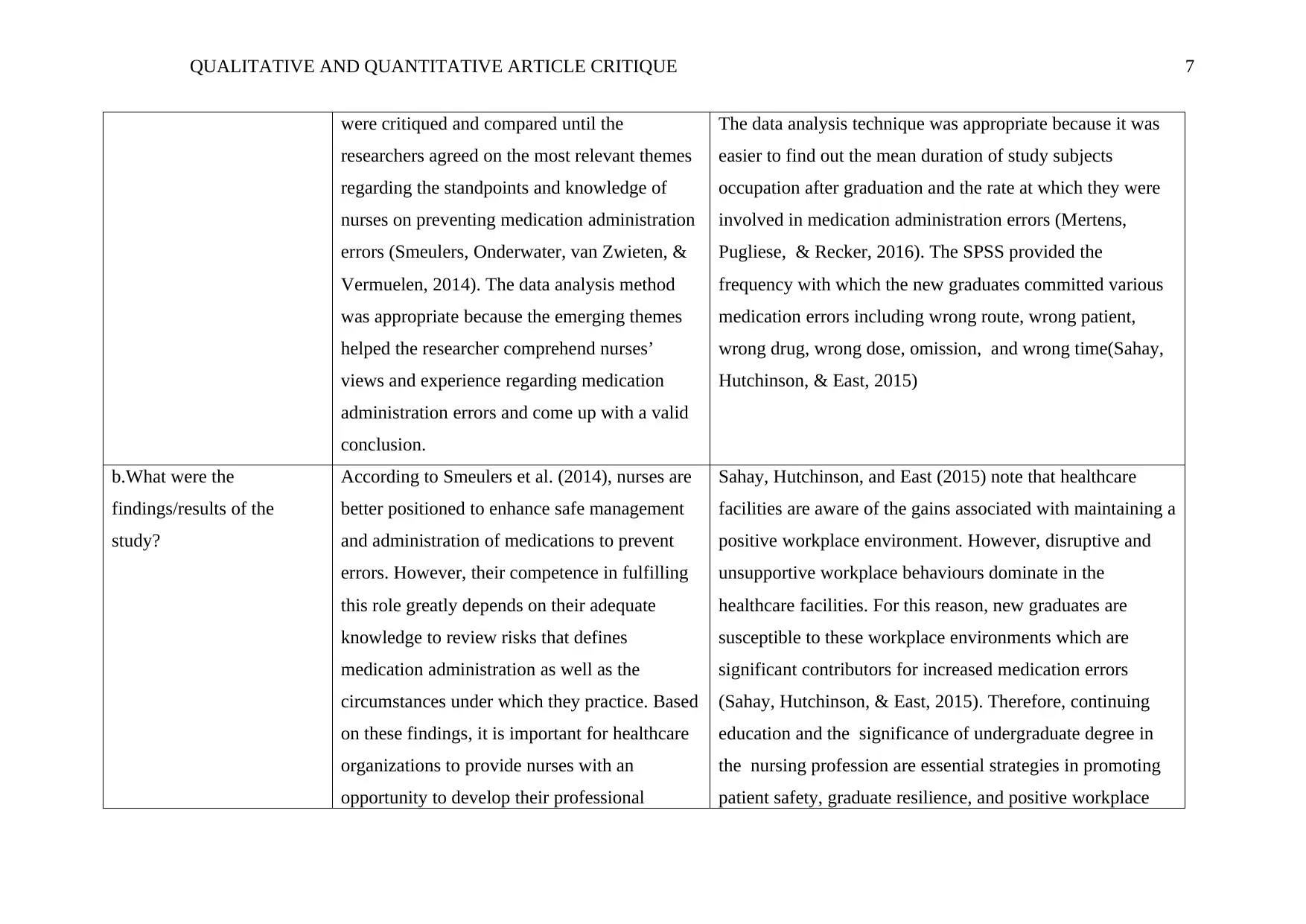
QUALITATIVE AND QUANTITATIVE ARTICLE CRITIQUE 7
were critiqued and compared until the
researchers agreed on the most relevant themes
regarding the standpoints and knowledge of
nurses on preventing medication administration
errors (Smeulers, Onderwater, van Zwieten, &
Vermuelen, 2014). The data analysis method
was appropriate because the emerging themes
helped the researcher comprehend nurses’
views and experience regarding medication
administration errors and come up with a valid
conclusion.
The data analysis technique was appropriate because it was
easier to find out the mean duration of study subjects
occupation after graduation and the rate at which they were
involved in medication administration errors (Mertens,
Pugliese, & Recker, 2016). The SPSS provided the
frequency with which the new graduates committed various
medication errors including wrong route, wrong patient,
wrong drug, wrong dose, omission, and wrong time(Sahay,
Hutchinson, & East, 2015)
b.What were the
findings/results of the
study?
According to Smeulers et al. (2014), nurses are
better positioned to enhance safe management
and administration of medications to prevent
errors. However, their competence in fulfilling
this role greatly depends on their adequate
knowledge to review risks that defines
medication administration as well as the
circumstances under which they practice. Based
on these findings, it is important for healthcare
organizations to provide nurses with an
opportunity to develop their professional
Sahay, Hutchinson, and East (2015) note that healthcare
facilities are aware of the gains associated with maintaining a
positive workplace environment. However, disruptive and
unsupportive workplace behaviours dominate in the
healthcare facilities. For this reason, new graduates are
susceptible to these workplace environments which are
significant contributors for increased medication errors
(Sahay, Hutchinson, & East, 2015). Therefore, continuing
education and the significance of undergraduate degree in
the nursing profession are essential strategies in promoting
patient safety, graduate resilience, and positive workplace
were critiqued and compared until the
researchers agreed on the most relevant themes
regarding the standpoints and knowledge of
nurses on preventing medication administration
errors (Smeulers, Onderwater, van Zwieten, &
Vermuelen, 2014). The data analysis method
was appropriate because the emerging themes
helped the researcher comprehend nurses’
views and experience regarding medication
administration errors and come up with a valid
conclusion.
The data analysis technique was appropriate because it was
easier to find out the mean duration of study subjects
occupation after graduation and the rate at which they were
involved in medication administration errors (Mertens,
Pugliese, & Recker, 2016). The SPSS provided the
frequency with which the new graduates committed various
medication errors including wrong route, wrong patient,
wrong drug, wrong dose, omission, and wrong time(Sahay,
Hutchinson, & East, 2015)
b.What were the
findings/results of the
study?
According to Smeulers et al. (2014), nurses are
better positioned to enhance safe management
and administration of medications to prevent
errors. However, their competence in fulfilling
this role greatly depends on their adequate
knowledge to review risks that defines
medication administration as well as the
circumstances under which they practice. Based
on these findings, it is important for healthcare
organizations to provide nurses with an
opportunity to develop their professional
Sahay, Hutchinson, and East (2015) note that healthcare
facilities are aware of the gains associated with maintaining a
positive workplace environment. However, disruptive and
unsupportive workplace behaviours dominate in the
healthcare facilities. For this reason, new graduates are
susceptible to these workplace environments which are
significant contributors for increased medication errors
(Sahay, Hutchinson, & East, 2015). Therefore, continuing
education and the significance of undergraduate degree in
the nursing profession are essential strategies in promoting
patient safety, graduate resilience, and positive workplace
Paraphrase This Document
Need a fresh take? Get an instant paraphrase of this document with our AI Paraphraser
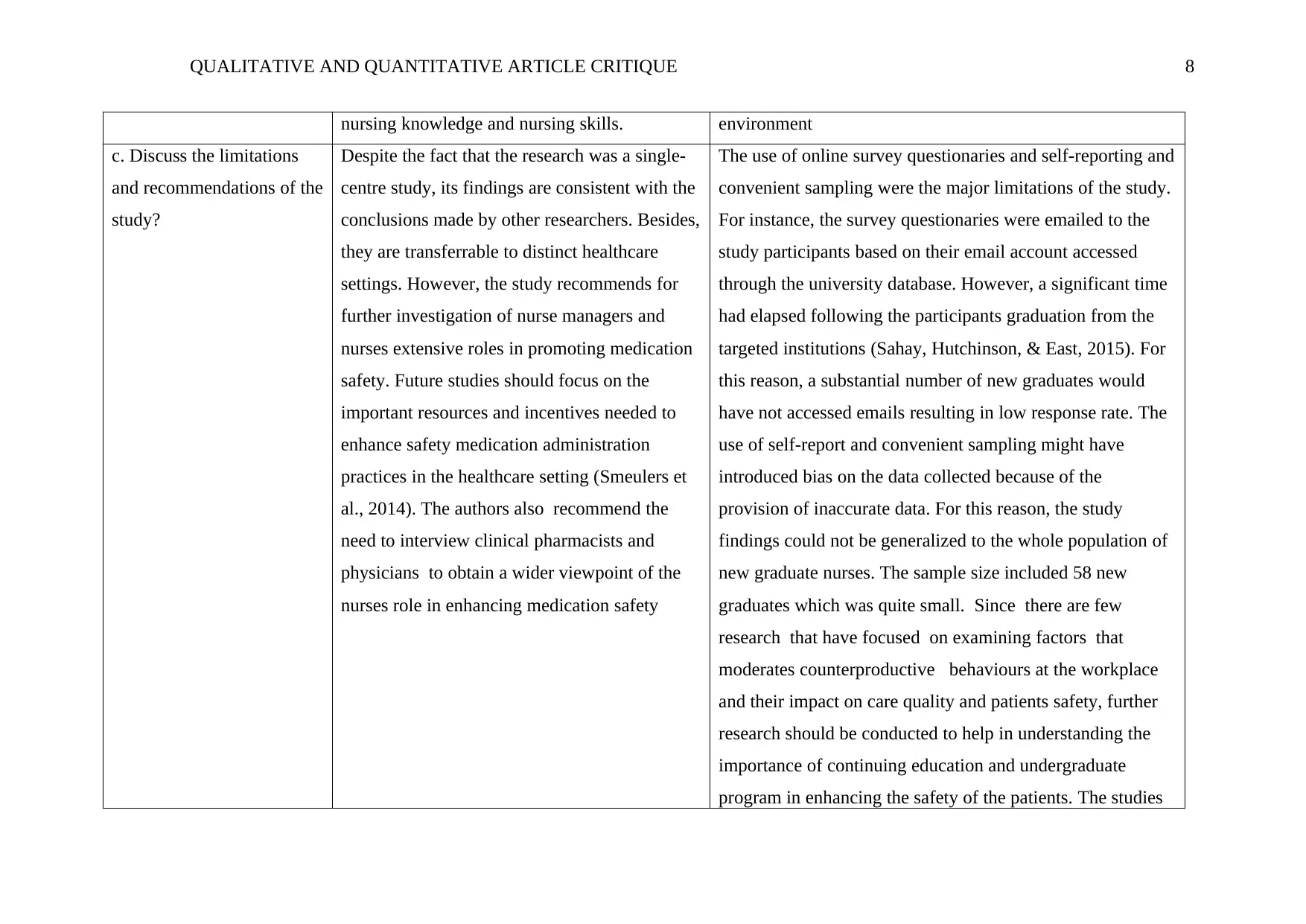
QUALITATIVE AND QUANTITATIVE ARTICLE CRITIQUE 8
nursing knowledge and nursing skills. environment
c. Discuss the limitations
and recommendations of the
study?
Despite the fact that the research was a single-
centre study, its findings are consistent with the
conclusions made by other researchers. Besides,
they are transferrable to distinct healthcare
settings. However, the study recommends for
further investigation of nurse managers and
nurses extensive roles in promoting medication
safety. Future studies should focus on the
important resources and incentives needed to
enhance safety medication administration
practices in the healthcare setting (Smeulers et
al., 2014). The authors also recommend the
need to interview clinical pharmacists and
physicians to obtain a wider viewpoint of the
nurses role in enhancing medication safety
The use of online survey questionaries and self-reporting and
convenient sampling were the major limitations of the study.
For instance, the survey questionaries were emailed to the
study participants based on their email account accessed
through the university database. However, a significant time
had elapsed following the participants graduation from the
targeted institutions (Sahay, Hutchinson, & East, 2015). For
this reason, a substantial number of new graduates would
have not accessed emails resulting in low response rate. The
use of self-report and convenient sampling might have
introduced bias on the data collected because of the
provision of inaccurate data. For this reason, the study
findings could not be generalized to the whole population of
new graduate nurses. The sample size included 58 new
graduates which was quite small. Since there are few
research that have focused on examining factors that
moderates counterproductive behaviours at the workplace
and their impact on care quality and patients safety, further
research should be conducted to help in understanding the
importance of continuing education and undergraduate
program in enhancing the safety of the patients. The studies
nursing knowledge and nursing skills. environment
c. Discuss the limitations
and recommendations of the
study?
Despite the fact that the research was a single-
centre study, its findings are consistent with the
conclusions made by other researchers. Besides,
they are transferrable to distinct healthcare
settings. However, the study recommends for
further investigation of nurse managers and
nurses extensive roles in promoting medication
safety. Future studies should focus on the
important resources and incentives needed to
enhance safety medication administration
practices in the healthcare setting (Smeulers et
al., 2014). The authors also recommend the
need to interview clinical pharmacists and
physicians to obtain a wider viewpoint of the
nurses role in enhancing medication safety
The use of online survey questionaries and self-reporting and
convenient sampling were the major limitations of the study.
For instance, the survey questionaries were emailed to the
study participants based on their email account accessed
through the university database. However, a significant time
had elapsed following the participants graduation from the
targeted institutions (Sahay, Hutchinson, & East, 2015). For
this reason, a substantial number of new graduates would
have not accessed emails resulting in low response rate. The
use of self-report and convenient sampling might have
introduced bias on the data collected because of the
provision of inaccurate data. For this reason, the study
findings could not be generalized to the whole population of
new graduate nurses. The sample size included 58 new
graduates which was quite small. Since there are few
research that have focused on examining factors that
moderates counterproductive behaviours at the workplace
and their impact on care quality and patients safety, further
research should be conducted to help in understanding the
importance of continuing education and undergraduate
program in enhancing the safety of the patients. The studies
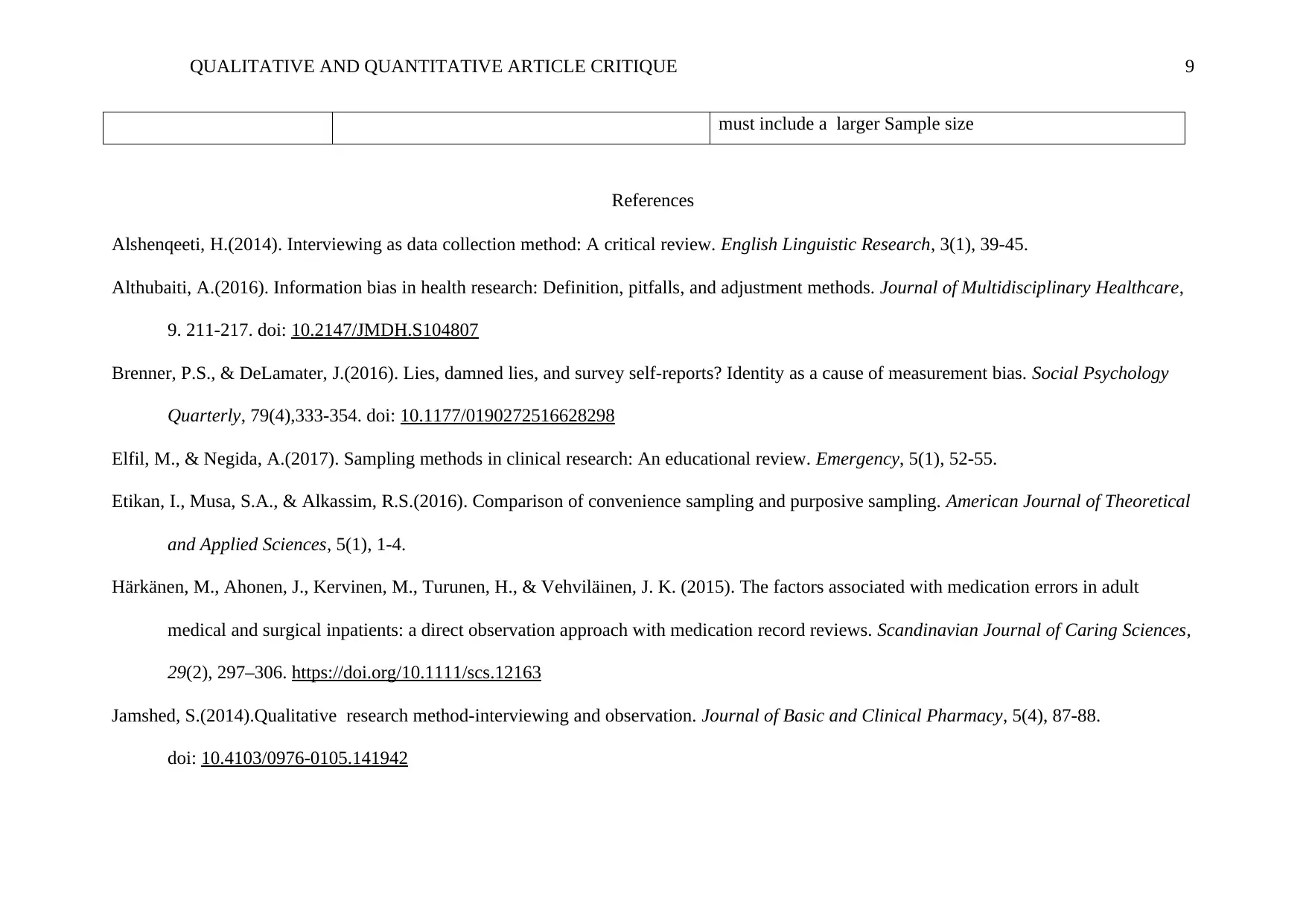
QUALITATIVE AND QUANTITATIVE ARTICLE CRITIQUE 9
must include a larger Sample size
References
Alshenqeeti, H.(2014). Interviewing as data collection method: A critical review. English Linguistic Research, 3(1), 39-45.
Althubaiti, A.(2016). Information bias in health research: Definition, pitfalls, and adjustment methods. Journal of Multidisciplinary Healthcare,
9. 211-217. doi: 10.2147/JMDH.S104807
Brenner, P.S., & DeLamater, J.(2016). Lies, damned lies, and survey self-reports? Identity as a cause of measurement bias. Social Psychology
Quarterly, 79(4),333-354. doi: 10.1177/0190272516628298
Elfil, M., & Negida, A.(2017). Sampling methods in clinical research: An educational review. Emergency, 5(1), 52-55.
Etikan, I., Musa, S.A., & Alkassim, R.S.(2016). Comparison of convenience sampling and purposive sampling. American Journal of Theoretical
and Applied Sciences, 5(1), 1-4.
Härkänen, M., Ahonen, J., Kervinen, M., Turunen, H., & Vehviläinen, J. K. (2015). The factors associated with medication errors in adult
medical and surgical inpatients: a direct observation approach with medication record reviews. Scandinavian Journal of Caring Sciences,
29(2), 297–306. https://doi.org/10.1111/scs.12163
Jamshed, S.(2014).Qualitative research method-interviewing and observation. Journal of Basic and Clinical Pharmacy, 5(4), 87-88.
doi: 10.4103/0976-0105.141942
must include a larger Sample size
References
Alshenqeeti, H.(2014). Interviewing as data collection method: A critical review. English Linguistic Research, 3(1), 39-45.
Althubaiti, A.(2016). Information bias in health research: Definition, pitfalls, and adjustment methods. Journal of Multidisciplinary Healthcare,
9. 211-217. doi: 10.2147/JMDH.S104807
Brenner, P.S., & DeLamater, J.(2016). Lies, damned lies, and survey self-reports? Identity as a cause of measurement bias. Social Psychology
Quarterly, 79(4),333-354. doi: 10.1177/0190272516628298
Elfil, M., & Negida, A.(2017). Sampling methods in clinical research: An educational review. Emergency, 5(1), 52-55.
Etikan, I., Musa, S.A., & Alkassim, R.S.(2016). Comparison of convenience sampling and purposive sampling. American Journal of Theoretical
and Applied Sciences, 5(1), 1-4.
Härkänen, M., Ahonen, J., Kervinen, M., Turunen, H., & Vehviläinen, J. K. (2015). The factors associated with medication errors in adult
medical and surgical inpatients: a direct observation approach with medication record reviews. Scandinavian Journal of Caring Sciences,
29(2), 297–306. https://doi.org/10.1111/scs.12163
Jamshed, S.(2014).Qualitative research method-interviewing and observation. Journal of Basic and Clinical Pharmacy, 5(4), 87-88.
doi: 10.4103/0976-0105.141942
⊘ This is a preview!⊘
Do you want full access?
Subscribe today to unlock all pages.

Trusted by 1+ million students worldwide
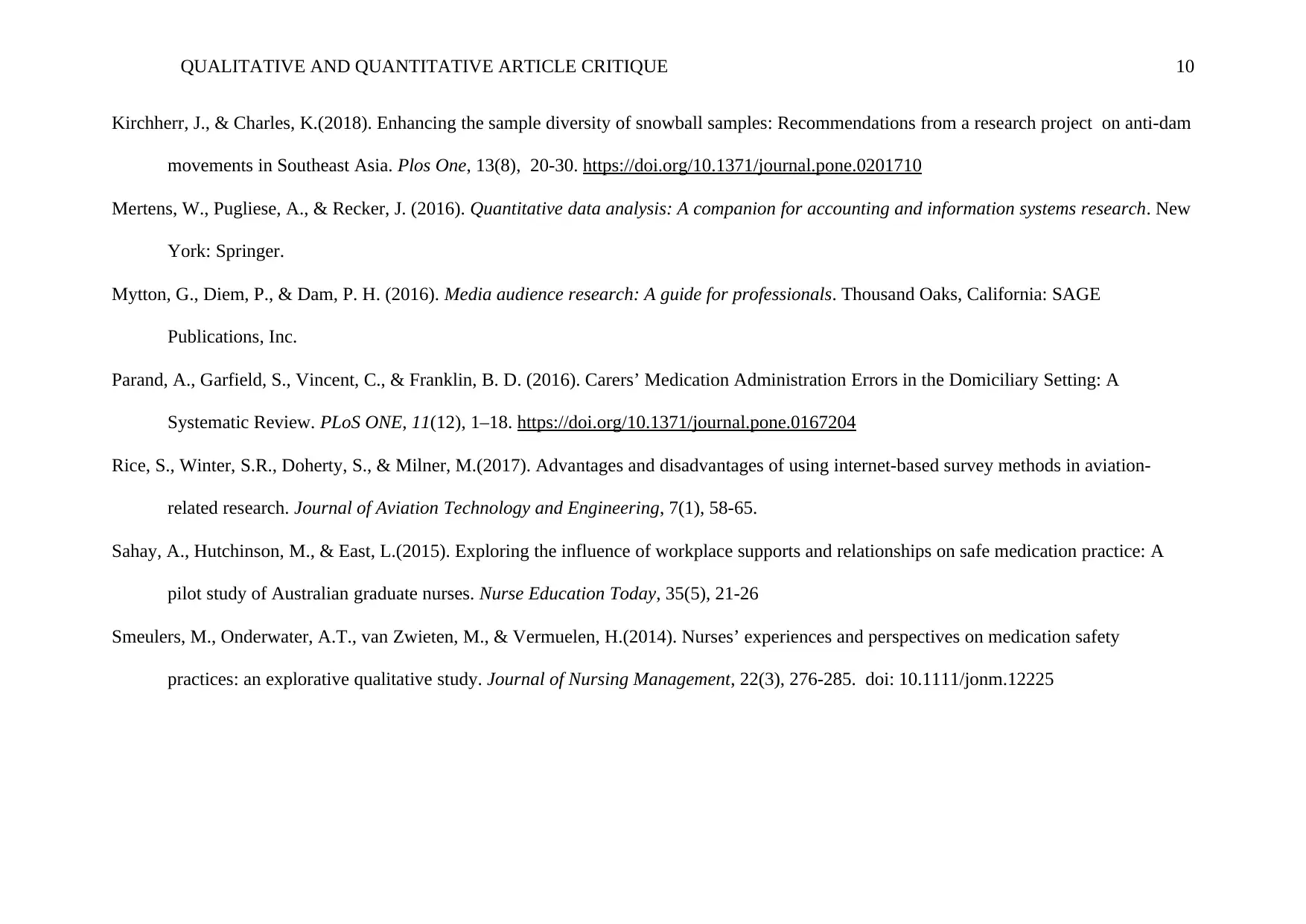
QUALITATIVE AND QUANTITATIVE ARTICLE CRITIQUE 10
Kirchherr, J., & Charles, K.(2018). Enhancing the sample diversity of snowball samples: Recommendations from a research project on anti-dam
movements in Southeast Asia. Plos One, 13(8), 20-30. https://doi.org/10.1371/journal.pone.0201710
Mertens, W., Pugliese, A., & Recker, J. (2016). Quantitative data analysis: A companion for accounting and information systems research. New
York: Springer.
Mytton, G., Diem, P., & Dam, P. H. (2016). Media audience research: A guide for professionals. Thousand Oaks, California: SAGE
Publications, Inc.
Parand, A., Garfield, S., Vincent, C., & Franklin, B. D. (2016). Carers’ Medication Administration Errors in the Domiciliary Setting: A
Systematic Review. PLoS ONE, 11(12), 1–18. https://doi.org/10.1371/journal.pone.0167204
Rice, S., Winter, S.R., Doherty, S., & Milner, M.(2017). Advantages and disadvantages of using internet-based survey methods in aviation-
related research. Journal of Aviation Technology and Engineering, 7(1), 58-65.
Sahay, A., Hutchinson, M., & East, L.(2015). Exploring the influence of workplace supports and relationships on safe medication practice: A
pilot study of Australian graduate nurses. Nurse Education Today, 35(5), 21-26
Smeulers, M., Onderwater, A.T., van Zwieten, M., & Vermuelen, H.(2014). Nurses’ experiences and perspectives on medication safety
practices: an explorative qualitative study. Journal of Nursing Management, 22(3), 276-285. doi: 10.1111/jonm.12225
Kirchherr, J., & Charles, K.(2018). Enhancing the sample diversity of snowball samples: Recommendations from a research project on anti-dam
movements in Southeast Asia. Plos One, 13(8), 20-30. https://doi.org/10.1371/journal.pone.0201710
Mertens, W., Pugliese, A., & Recker, J. (2016). Quantitative data analysis: A companion for accounting and information systems research. New
York: Springer.
Mytton, G., Diem, P., & Dam, P. H. (2016). Media audience research: A guide for professionals. Thousand Oaks, California: SAGE
Publications, Inc.
Parand, A., Garfield, S., Vincent, C., & Franklin, B. D. (2016). Carers’ Medication Administration Errors in the Domiciliary Setting: A
Systematic Review. PLoS ONE, 11(12), 1–18. https://doi.org/10.1371/journal.pone.0167204
Rice, S., Winter, S.R., Doherty, S., & Milner, M.(2017). Advantages and disadvantages of using internet-based survey methods in aviation-
related research. Journal of Aviation Technology and Engineering, 7(1), 58-65.
Sahay, A., Hutchinson, M., & East, L.(2015). Exploring the influence of workplace supports and relationships on safe medication practice: A
pilot study of Australian graduate nurses. Nurse Education Today, 35(5), 21-26
Smeulers, M., Onderwater, A.T., van Zwieten, M., & Vermuelen, H.(2014). Nurses’ experiences and perspectives on medication safety
practices: an explorative qualitative study. Journal of Nursing Management, 22(3), 276-285. doi: 10.1111/jonm.12225
1 out of 10
Related Documents
Your All-in-One AI-Powered Toolkit for Academic Success.
+13062052269
info@desklib.com
Available 24*7 on WhatsApp / Email
![[object Object]](/_next/static/media/star-bottom.7253800d.svg)
Unlock your academic potential
Copyright © 2020–2025 A2Z Services. All Rights Reserved. Developed and managed by ZUCOL.





